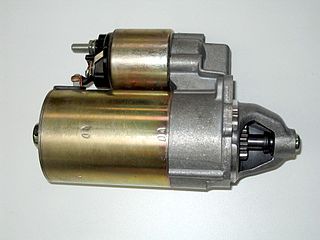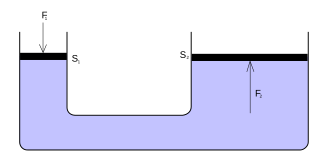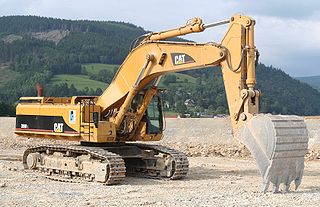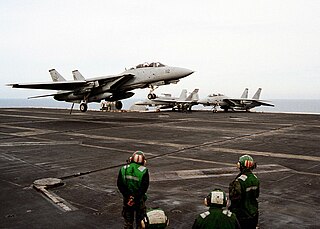
A starter is a device used to rotate (crank) an internal-combustion engine so as to initiate the engine's operation under its own power. Starters can be electric, pneumatic, or hydraulic. In the case of very large engines, the starter can even be another internal-combustion engine.

Excavators (hydraulic) are heavy construction equipment consisting of a boom, dipper, bucket and cab on a rotating platform known as the "house". The house sits atop an undercarriage with tracks or wheels. They are a natural progression from the steam shovels and often mistakenly called power shovels. All movement and functions of a hydraulic excavator are accomplished through the use of hydraulic fluid, with hydraulic cylinders and hydraulic motors. Due to the linear actuation of hydraulic cylinders, their mode of operation is fundamentally different from cable-operated excavators which use winches and steel ropes to accomplish the movements.

A crane is a type of machine, generally equipped with a hoist rope, wire ropes or chains, and sheaves, that can be used both to lift and lower materials and to move them horizontally. It is mainly used for lifting heavy things and transporting them to other places. The device uses one or more simple machines to create mechanical advantage and thus move loads beyond the normal capability of a human. Cranes are commonly employed in the transport industry for the loading and unloading of freight, in the construction industry for the movement of materials, and in the manufacturing industry for the assembling of heavy equipment.

A lawn mower is a machine utilizing one or more revolving blades to cut a grass surface to an even height. The height of the cut grass may be fixed by the design of the mower, but generally is adjustable by the operator, typically by a single master lever, or by a lever or nut and bolt on each of the machine's wheels. The blades may be powered by manual force, with wheels mechanically connected to the cutting blades so that when the mower is pushed forward, the blades spin, or the machine may have a battery-powered or plug-in electric motor. The most common self-contained power source for lawn mowers is a small internal combustion engine. Smaller mowers often lack any form of propulsion, requiring human power to move over a surface; "walk-behind" mowers are self-propelled, requiring a human only to walk behind and guide them. Larger lawn mowers are usually either self-propelled "walk-behind" types, or more often, are "ride-on" mowers, equipped so the operator can ride on the mower and control it. A robotic lawn mower is designed to operate either entirely on its own, or less commonly by an operator by remote control.

A check valve, clack valve, non-return valve, reflux valve, retention valve or one-way valve is a valve that normally allows fluid to flow through it in only one direction.

Fluid power is the use of fluids under pressure to generate, control, and transmit power. Fluid power is subdivided into hydraulics using a liquid such as mineral oil or water, and pneumatics using a gas such as air or other gases. Compressed-air and water-pressure systems were once used to transmit power from a central source to industrial users over extended geographic areas; fluid power systems today are usually within a single building or mobile machine.

The Millau Viaduct is a cable-stayed bridge that spans the gorge valley of the Tarn near Millau in southern France. In a Franco-British partnership, it was designed by the English architect Lord Norman Foster and French structural engineer Michel Virlogeux. As of November 2018, it is the tallest bridge in the world, having a structural height of 343 metres (1,125 ft).

Hydraulic machines are machinery and tools that use liquid fluid power to do simple work, operated by the use of hydraulics, where a liquid is the powering medium. In heavy equipment and other types of machine, hydraulic fluid is transmitted throughout the machine to various hydraulic motors and hydraulic cylinders and becomes pressurised according to the resistance present. The fluid is controlled directly or automatically by control valves and distributed through hoses and tubes.

A moveable bridge, or movable bridge, is a bridge that moves to allow passage for boats or barges. In American English, movable bridge and drawbridge are synonymous, and the latter is the common term, but drawbridge can be limited to the narrower, historical definition used in some other forms of English, in which drawbridge refers only to a specific type of moveable bridge.
In automobiles, power steering is a device that helps drivers steer by augmenting steering effort of the steering wheel.

The Barton Swing Aqueduct is a moveable navigable aqueduct in Barton upon Irwell, Greater Manchester, England. It carries the Bridgewater Canal across the Manchester Ship Canal. The swinging action allows large vessels using the ship canal to pass underneath and smaller craft, both narrowboats and broad-beam barges to cross over the top. The aqueduct, the first and only swing aqueduct in the world, is a Grade II* listed building, and considered a major feat of Victorian civil engineering. Designed by Sir Edward Leader Williams and built by Andrew Handyside and Company of Derby, the swing bridge opened in 1894 and remains in regular use.

An arresting gear, or arrestor gear, is a mechanical system used to rapidly decelerate an aircraft as it lands. Arresting gear on aircraft carriers is an essential component of naval aviation, and it is most commonly used on CATOBAR and STOBAR aircraft carriers. Similar systems are also found at land-based airfields for expeditionary or emergency use. Typical systems consist of several steel wire ropes laid across the aircraft landing area, designed to be caught by an aircraft's tailhook. During a normal arrestment, the tailhook engages the wire and the aircraft's kinetic energy is transferred to hydraulic damping systems attached below the carrier deck. There are other related systems which use nets to catch aircraft wings or landing gear. These barricade and barrier systems are only used for emergency arrestments for aircraft without operable tailhooks.

A hydraulic cylinder is a mechanical actuator that is used to give a unidirectional force through a unidirectional stroke. It has many applications, notably in construction equipment, manufacturing machinery, and civil engineering.

The EMD 567 is a line of large medium-speed diesel engines built by General Motors' Electro-Motive Division. This engine, which succeeded Winton's 201A, was used in EMD's locomotives from 1938 until its replacement in 1966 by the EMD 645. It has a bore of 8 1⁄2 in (216 mm), a stroke of 10 in (254 mm) and a displacement of 567 cu in (9.29 L) per cylinder. Like the 201A, the EMD 645 and the EMD 710, the EMD 567 is a two-cycle engine.

A hydraulic motor is a mechanical actuator that converts hydraulic pressure and flow into torque and angular displacement (rotation). The hydraulic motor is the rotary counterpart of the hydraulic cylinder as a linear actuator. Most broadly, the category of devices called hydraulic motors has sometimes included those that run on hydropower—namely, water engines and water motors—but in today's terminology the name usually refers more specifically to motors that use hydraulic fluid as part of closed hydraulic circuits in modern hydraulic machinery.
Artificial lift refers to the use of artificial means to increase the flow of liquids, such as crude oil or water, from a production well. Generally this is achieved by the use of a mechanical device inside the well or by decreasing the weight of the hydrostatic column by injecting gas into the liquid some distance down the well. A newer method called Continuous Belt Transportation (CBT) uses an oil absorbing belt to extract from marginal and idle wells. Artificial lift is needed in wells when there is insufficient pressure in the reservoir to lift the produced fluids to the surface, but often used in naturally flowing wells to increase the flow rate above what would flow naturally. The produced fluid can be oil, water or a mix of oil and water, typically mixed with some amount of gas.

The Spit Bridge, a steel and concrete girder bridge with a bascule lift span across the Middle Harbour, is located 10 kilometres (6.2 mi) northeast of the central business district in Sydney, New South Wales, Australia. The bridge carries The Spit Road (A8) from a point called The Spit, and connects the suburbs of Mosman, on the south bank and Seaforth, on the north bank.
The Spit Bridge, completed in 1958, is of state significance. It is a substantial landscape feature that has played a crucial role in allowing the development of the northern beaches suburbs to occur over the last 44 years. The Bridge is also extremely rare as it is the only lift bridge still operational on a major arterial road. As such, the Spit Bridge is representative of all the major lift bridges that were once a common sight throughout NSW. The relative lack of modification to the original design of the Bridge also contributes to its level of significance. Historically the Bridge has a high level of significance developed primarily through being part of an important local transport route that has been in operation over a large period of time in several different guises. The Spit Bridge Cultural Landscape also contains the remnant features and locales of the former bridge and punt crossing and the remains of other transportation links such as the tramways. These additional items add to the significance of the Bridge through their ability to add to contextualise the current bridge as a single element of the crossing points colourful history.
A hydraulic drive system is a quasi-hydrostatic drive or transmission system that uses pressurized hydraulic fluid to power hydraulic machinery. The term hydrostatic refers to the transfer of energy from pressure differences, not from the kinetic energy of the flow.

The oil pump in an internal combustion engine circulates engine oil under pressure to the rotating bearings, the sliding pistons and the camshaft of the engine. This lubricates the bearings, allows the use of higher-capacity fluid bearings and also assists in cooling the engine.

The Bandini 1100 is a car model produced from 1947 until 1950 by the Italian company Bandini Cars. It was the successor to the early 1946 model. A racing version was produced under the name Bandini 1100 siluro.





















